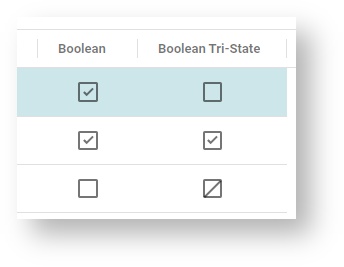...
| Value for 'classification' | Property Type | Description | ||
|---|---|---|---|---|
email | string | An e-mail icon is displayed beside the form field. A click on the icon opens the locally installed e-mail client with the e-mail address specified. The entered value is validated via an internal browser function. Valid addresses have to match the standard. Note: Values like | ||
url | string | A URL icon is displayed beside the form field. A click on the icon opens the specified URL in a browser. The entered value is validated via an internal browser function. Valid addresses have to match the standard. | ||
phone | string | A phone icon is displayed beside the form field. A click on the icon opens the specified number in the available phone application. In Chrome, a connected Android phone can be used. No validation takes place. | ||
| string | Useful for properties that store a user ID and appear with the corresponding user name. As soon as users start typing in the form field, a selection list with user names is provided for which the entered term was found in the user name, name, surname or e-mail address. If users select one of them, the corresponding user ID is stored as property value while the user name is shown in the form as a chip. If roles are specified, only user names of users having at least one of those roles are offered for the corresponding form field. | ||
| string | Useful for properties that store an object type ID or an object ID and appear with the corresponding object type or object name. As soon as users start typing in the form field, a selection list with matching object type or object names is provided. If users select one of them, the corresponding object type ID or object ID is stored while the name is shown in the form as a chip. If no name is available, the ID is displayed instead. For object ID property fields, an Anchor icon is additionally displayed beside the form field. A click on this icon opens the referenced object. For object type ID property fields, it is possible to limit the object types that are offered to users in the selection list. For this purpose, specify all object type IDs to be considered in the | ||
catalog[new,draft,review,released,rejected] | string | Configuration of a static catalog. Users can only select the values specified in the list. Only one language is supported here. | ||
Pattern to be used in the global schema: Pattern to be used in an app schema: Pattern to be used in a tenant schema: | string | Configuration of a dynamic catalog that can be maintained per tenant. Users can only select the values specified in the list. Users with the YUUVIS_MANAGE_SETTINGS role can deactivate and remove values or add new values if the optional parameter The catalog values are stored separately for each tenant. It is possible to set up standard values for each catalog using a specific system controller endpoint of the Web-API Gateway. If no tenant-specific variant has been saved so far, the standard values are used. | ||
| string | Retrieves the catalog values from a custom microservice that is called via the specified URL. The URL can be absolute (e.g., The internal token with the user information is transferred to the microservice. The language set by the user can be read from the header. The response format must have the following JSON structure:
| ||
digit | number | Numbers are rendered with a delimiter, e.g., 123,456,789.35. Otherwise, no digital grouping is used, e.g., 123456789.35. | ||
sortable | table | Enables the user to sort table rows manually by drag & drop. | ||
switch | boolean | Values are represented by a switch with the available positions Per default (if | ||
| any type | The property is not displayed in any standard form by the client application. | ||
| any type | The property is not displayed in the summary aspect area of objects displayed by the client application. |
...

